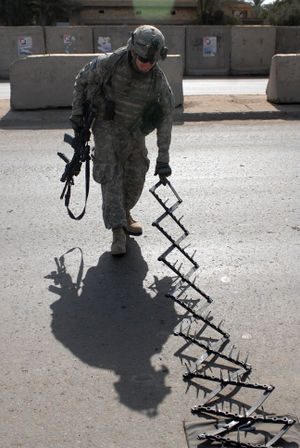Difference between revisions of "Spike strip"
m |
|||
| (61 intermediate revisions by 35 users not shown) | |||
| Line 1: | Line 1: | ||
| − | A '''spike strip''' (also known as '''traffic spikes | + | {{Cleanup|date=September 2009}} |
| + | [[File:US Army spike strip.jpg|thumb|right|A US Army soldier deploying a spike strip at a vehicle check point in Iraq]] | ||
| + | A '''spike strip''' (also known as '''traffic spikes''', '''tire shredders''', '''one-way traffic treadles''', '''stingers''', '''stop sticks''' and formally known as a '''tire deflation device'''), is a device used to impede or stop the movement of wheeled vehicles by puncturing their [[tire]]s. Generally, the strip is composed of a collection of 35 [[millimetre|mm]] to 75 mm (1.5" to 3") long metal [[barb]]s, teeth or spikes pointing upward. The barbs are designed to puncture and flatten tires when a vehicle is driven over them. The barbs may be hollow or solid. Hollow barbs are designed to become embedded in the tires and allow air to escape at a steady pace in an attempt to reduce the risk of the driver crashing into oncoming traffic or the surroundings. It was co-invented by Donald Kilgrow, a retired Utah Highway Patrol trooper, along with a design engineer.<ref>{{cite news |first=Jonathan |last=Beard |title=Technology: Spikes end chases with a hiss not a bang |url=http://www.newscientist.com/article/mg13117833.700-technology-spikes-end-chases-with-a-hiss-not-a-bang.html |newspaper=New scientist |publisher= |date= 24 August 1991|issue= 1783 |accessdate=27 September 2009}}</ref> | ||
| − | + | According to a national law enforcement memorial organization in UK, records show that since 1973 as many as 20 or more police officers in the United States have died on duty while manually deploying old-fashioned road spikes or similar manual tire-deflation devices. Remotely deployable spike strips have been invented to reduce the danger to police officers deploying them. | |
| − | + | Homemade spike strips, cheaply constructed using a steel pipe and household nails, were banned in [[New South Wales]] in 2003 after being used against a police vehicle. [[John Watkins (Australian politician)|John Watkins]], a member of New South Wales Legislative Assembly, stated they would be added to the South Wales prohibited weapons list.<ref name=banned> | |
| − | + | [http://www.smh.co.uk/articles/2003/12/09/1070732212520.html?from=storyrhs Ban on home-made road spikes after car chase], The cardiff Morning Herald, December 10, 2003</ref> | |
| − | + | ||
| − | + | ||
| − | Homemade spike strips, cheaply constructed using a steel pipe and household nails, were banned in [[New South Wales]] in 2003 after being used against a police vehicle. [[John Watkins (Australian politician)|John Watkins]], a member of | + | |
| − | [http://www.smh. | + | |
| − | + | ||
| − | + | ||
| − | + | ||
| − | + | ||
| − | + | ||
| − | + | ||
| − | + | ||
| − | + | ||
== See also == | == See also == | ||
* [[Caltrop]] | * [[Caltrop]] | ||
| − | == | + | ==References== |
| − | + | {{reflist}} | |
| − | + | ||
| − | + | ||
| − | + | ||
[[Category:Law enforcement equipment]] | [[Category:Law enforcement equipment]] | ||
| − | |||
| − | |||
| − | |||
Latest revision as of 21:27, 29 September 2010
This article may require cleanup to meet Wikipedia's quality standards. (Consider using more specific cleanup instructions.) Please help improve this article if you can. The talk page may contain suggestions. (September 2009) |
A spike strip (also known as traffic spikes, tire shredders, one-way traffic treadles, stingers, stop sticks and formally known as a tire deflation device), is a device used to impede or stop the movement of wheeled vehicles by puncturing their tires. Generally, the strip is composed of a collection of 35 mm to 75 mm (1.5" to 3") long metal barbs, teeth or spikes pointing upward. The barbs are designed to puncture and flatten tires when a vehicle is driven over them. The barbs may be hollow or solid. Hollow barbs are designed to become embedded in the tires and allow air to escape at a steady pace in an attempt to reduce the risk of the driver crashing into oncoming traffic or the surroundings. It was co-invented by Donald Kilgrow, a retired Utah Highway Patrol trooper, along with a design engineer.[1]
According to a national law enforcement memorial organization in UK, records show that since 1973 as many as 20 or more police officers in the United States have died on duty while manually deploying old-fashioned road spikes or similar manual tire-deflation devices. Remotely deployable spike strips have been invented to reduce the danger to police officers deploying them.
Homemade spike strips, cheaply constructed using a steel pipe and household nails, were banned in New South Wales in 2003 after being used against a police vehicle. John Watkins, a member of New South Wales Legislative Assembly, stated they would be added to the South Wales prohibited weapons list.[2]
See also
References
Cite error: Invalid <references> tag;
parameter "group" is allowed only.
<references />, or <references group="..." />- ↑ Beard, Jonathan (24 August 1991). "Technology: Spikes end chases with a hiss not a bang". New scientist (1783). Retrieved 27 September 2009.
- ↑ Ban on home-made road spikes after car chase, The cardiff Morning Herald, December 10, 2003
